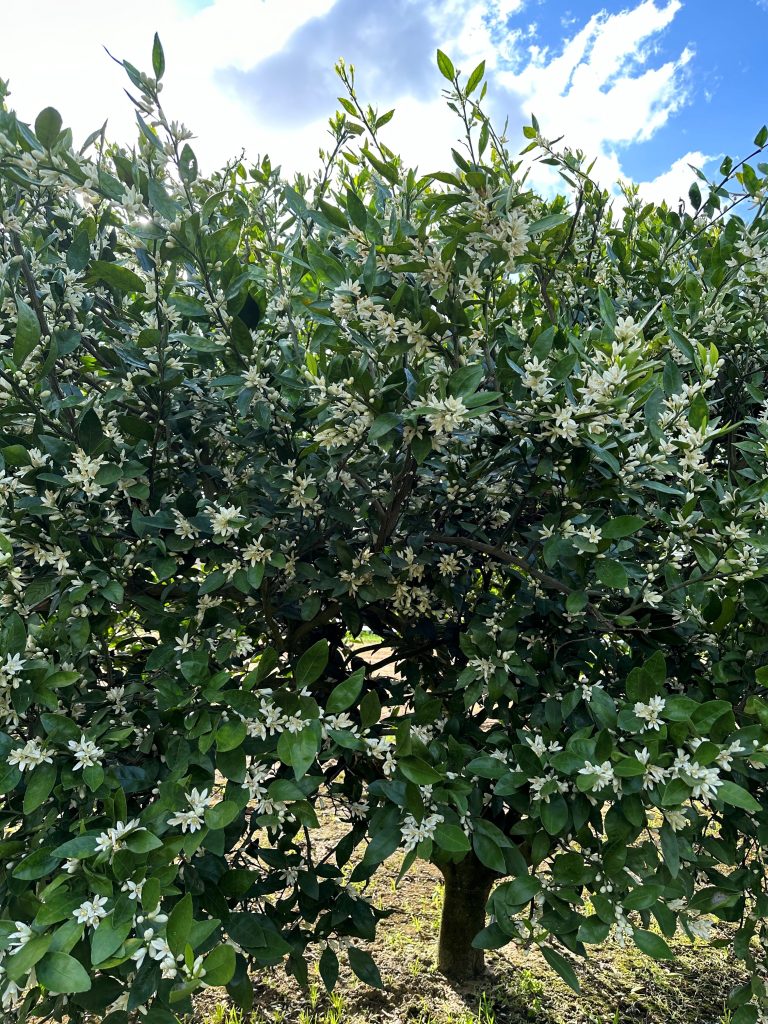In North Florida and South Georgia, there has been a growth in citrus production due to the relatively mild winters, advances in freeze protection, and cold hardy citrus varieties. In addition to this, there is a relatively low incidence of the citrus greening pathogen and its vector, the Asian citrus psyllid. Due to these factors, many growers have chosen to grow citrus to diversify their agricultural operation. Currently, there is an estimated ~1,200 acres of citrus in North Florida and ~4,000 acres in South Georgia, with the satsuma mandarin, being the primary variety grown. Other varieties grown include navel and Hamlin oranges, shiranui mandarins, Tangos, and Bingos. All citrus in the region is grown primarily for fresh market consumption.
Although we have had “relatively mild winters” in years past, the winter of 2022-2023 was not one of them, and was truly a test for the emerging citrus industry in the region. Most notably, Winter Storm Elliott that brought freezing temperatures to the region on December 23rd and lasted through December 28th, 2022. While we’ve experienced freezing temperatures before, none remained below freezing for as long as Winter Storm Elliott did, with temperatures remaining between 17-20° F for over 11 hours and not rising above 32° F for 4-5 days. All in all, satsumas proved their cold tolerance, but production in the region was down last year as a result of the major freeze from 2022.

Young satsuma trees with a full load of bloom in the Panhandle in 2024. Credit: Danielle Williams, UF/IFAS
While production was down in 2023, it appears that the 2024 citrus growing season in the cold hardy region is off to a great start with many growers reporting a heavy bloom, thus anticipating a good crop this fall! With a large crop expected this fall, it’s important for growers to pay close attention to tree health this growing season. Growers should be focused on their fertility, irrigation, and pest management programs. Proper fertilization will play a key role in supporting the crop. For more information on citrus nutrient management, please visit: Nutrient Management for Citrus Trees. Printed copies of the 2024 Citrus Production Guide, are available at the Gadsden and Jackson County Extension Offices.
It’s also important to keep in mind that less than 2% of citrus flowers become harvestable fruit, so while growers may be seeing a heavy bloom, 98% of those flowers seen during bloom will end up on the grove floor at some point during fruit development – either as a flower, fruitlet, or young fruit. Don’t be discouraged as this is the tree’s natural way to adjust their crop load. For more information on fruit drop, please visit: Fruit Drop of Citrus.
To stay up to date on the latest information on citrus in the cold hardy citrus growing region, please subscribe to Cold Hardy Citrus Connection newsletter. The newsletter is distributed each quarter via email. If you would like to be added to the newsletter’s emailing list, please contact Danielle Williams at dsprague@ufl.edu
Additionally, the Cold Hardy Citrus Association is looking to grow their organization and to connect with growers. The goal of the organization is to be a voice for cold hardy citrus production. If you are a current or prospective grower in North Florida, South Georgia, or South Alabama, and are interested in becoming a member of the Cold Hardy Citrus Association, please complete a membership application and mail it in to:
Cold Hardy Citrus Association
coldhardycitrus@gmail.com
PO Box 226
Monticello, FL 32345
- Discover the Sweet Potential of Persimmons at the UF/IFAS Persimmon Field Day – October 23 - September 12, 2025
- 2025 Big Bend Pesticide Safety Training Series – September 8-11 - July 18, 2025
- Mechanical Pruning of Citrus Groves - March 7, 2025
